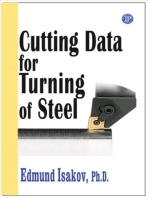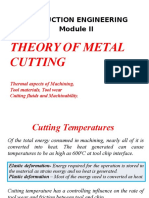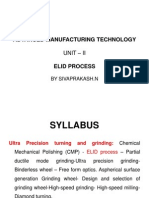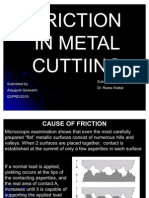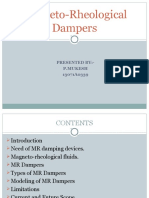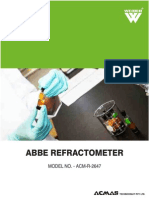Hot Machining
Hot Machining
Uploaded by
pavi32Copyright:
Available Formats
Hot Machining
Hot Machining
Uploaded by
pavi32Copyright
Available Formats
Share this document
Did you find this document useful?
Is this content inappropriate?
Copyright:
Available Formats
Hot Machining
Hot Machining
Uploaded by
pavi32Copyright:
Available Formats
PROCEEDINGS OF WORLD ACADEMY OF SCIENCE, ENGINEERING AND TECHNOLOGY VOLUME 36 DECEMBER 2008 ISSN 2070-3740
Investigation of Tool Temperature and Surface Quality in Hot Machining of Hard-to-Cut Materials
M.Davami, M.Zadshakoyan
AbstractProduction of hard-to-cut materials with uncoated carbide cutting tools in turning, not only cause tool life reduction but also, impairs the product surface roughness. In this paper, influence of hot machining method were studied and presented in two cases. Case1-Workpiece surface roughness quality with constant cutting parameter and 300C initial workpiece surface temperature. Case 2Tool temperature variation when cutting with two speeds 78.5 (m/min) and 51 (m/min). The workpiece material and tool used in this study were AISI 1060 steel (45HRC) and uncoated carbide TNNM 120408-SP10(SANDVIK Coromant) respectively. A gas flam heating source was used to preheating of the workpiece surface up to 300 C, causing reduction of yield stress about 15%. Results obtained experimentally, show that the method used can considerably improved surface quality of the workpiece. KeywordsHard-to-cut material, roughness, Tool Temperature
Hot machining, Surface
URING the two past decay, there has been significant industrial interest in machining hard-to-cut materials. These materials are being used in producing component for electrical, chemical, dental orthopedic, aerospace and nuclear industry, where high dimensional accuracy, tool life and satisfactory surface roughness quality is indeed. According to chemicals composition and mechanical characteristics of the materials four group of hard-to-cut material may be distinguished [1]. These are (1) Chilled cast iron, (2) Steel with hardness over 50 RC hard, (3) Steel that surface is hardened with cobalt, and (4) Steels hardened by alloy additions. For machining of hard-to-cut steel to cut, the cutting tools materials must be harder than workpiece materials. Due to expensive cost of cutting such materials, the different machining methods are being used. Practical guides for the economic machining of hard-to-cut materials, aerospace, super alloys, were proposed [2]. Usually, formation of second phase particles makes the alloy both stronger and more abrasive and thus more difficult to machine. Advantage, therefore, lies in machining in the soft state. A positive rake cutting edge is recommended for semi finishining and finishining operation wherever possible.
I. INTRODUCTION
Positive rake geometry minimizes work hardening of the machined surface by shearing the chip away from the workpiece in an efficient way in addition to minimizing buildup edge. Very light hones or even sharp insert edge are useful in preventing material build-up and improving surface finish during machining. Dull or improving build up edge increase cutting force during machining, causing metal build up, tearing and deflection of workpiece material. The sharp tools are more fragile and susceptible to chipping during machining, thus honed edges are recommended for most roughing operation. Sharp edges are used for finishing operations. The other guides are: - A large noise radius - Use a rigid set up, preventing vibration and subsequent chatter - Prevent part deflection - Use a high read angle - Use of filler metals, special fixturing, to prevent movement during machining - Vary the depth of cut, when more than one pass is required Also machinability of hard-to-cut materials can be improved by employing ramping (taper turning) technique, high pressure coolant supply technology, cryogenic machining, use of self propelled rotary tooling and hot machining. In hot machining, preheating of the workpiece can be performed before and/or during cutting. The workpiece temperature was chosen above the recrystallisation temperature, where the yield stress of materials decreased rapidly [3]. The yield strength of the structural steel (C355) tend to decrease, when its temperature increasing.Fig.1.
Authors are with the Tabriz University, Tabriz, e-mail: zadshakoyan@tabrizu.ac.ir, e-mail: modavami@gmail.com
Iran.
Fig. 1 Effect of Temperature on the yield Stress[3]
PWASET VOLUME 36 DECEMBER 2008 ISSN 2070-3740
687
2008 WASET.ORG
PROCEEDINGS OF WORLD ACADEMY OF SCIENCE, ENGINEERING AND TECHNOLOGY VOLUME 36 DECEMBER 2008 ISSN 2070-3740
Consequently, cutting force or power consumption and tool wear rate decrease. In this condition high integrity of machined surface with low cost could be obtained. The use of hot machining as a technique for improving machining operation, has been under consideration since the late 19th century. This was informed by understanding that metals, tend to deform more easily when heated, thus enhancing machining. The principle behind hot machining is the reduction of the large difference in hardness of workpiece leadining to reduction in the component force, improving surface finish and longer tool life [4]. Tighes use machining with heating workpiece in 1888. In early stages, materials difficult to machine under normal conditions such as Stainless Steel, S-816alloy, X-alloy, Inconel-X, Timken 16-25-6 and Navy Grade V, a nickel Chromium Steel have been hot machined by Tour and Fletcher, Armastrong, Krabacher and Merchant, Schmidt and Roubik, Krabacher and Merchant observed that at an optimum temperature the tool life raises to a maximum value and after that it reduces. Another important observation made by Shaw is that the strain-harden ability and flow stress of material reduces with increase in temperature in hot machining. Heating source is important in this process and selecting non ideal heating may induce unwanted structural changes or making more dimensions inaccuracy. The heating techniques include electric current, high frequency induction(Fig 2), plasma jet, gas flam [1].
Roughuram and Mujo carried out hot machining by magnetization field in hot machining. Ozler et al.[1] carried out hot machining operation using austenitic manganese steel as workpiece material and using gas flam heating. They show experimentally the effectiveness of hot machining technique under condition where the workpiece temperature set to 200C,400C and 600C .They were obtained that tool life increasing 3 times, when the workpiece surface temperature is set to 400 C. High manganese steel was machined in their study. Wang et al [6] have been reported the benefits of hybrid machining of Nickel base Inconel 718 alloys. N.Tosun and Ozler [7, 8] were used hot machining technique in turning operation. The optimization of the turning operation with multiple performance characteristics, tool life and workpiece surface roughness, was studied using weighted factor to improve the tool life and the workpiece surface roughness. The parameter design method proposed by Taguchi was adopted. Experimental results obtained, when cutting high manganese steel heated with the liquid petroleum gas (LPG) flam, were presented. They improved the approach proposed. Maity et al [9] invested hot-machining operation of high manganese steel using flam heating. A tool life equation has been founded from their statistical analysis. Fig 3.
Fig. 3 Hot Machining Setup [9] Fig. 2 Induction Heating in the Hot Machining [5]
Barrow studied the wear of carbide tools during hot machining of alloy steels. He used electric current heating. Ghosh and Basu carried out temperature distribution in a rotating cylinder with steady point heat source at the surface. Dutta carried out hot machining by friction heating. Mukherjee and Basu carried out statistical evaluation of metal cutting parameters in hot machining. They used Nickel Chromium Steel as the workpiece material with hardness of 440 BHN. He measured tool life and surface finish. They also observed that surface roughness decreases more considerably with increase in temperature than that of cutting velocity. They concluded that the influence of workpiece temperature on surface roughness is much more pronounced than on tool life. Meakawa and Kubo performed plasma hot machining for high hardness metal and new engineering materials.
In this paper, hard-to-cut steel AISI 1060(45HRC) heated by flam, and machined under constant cutting parameter, cutting speed, feed rate, depth of cut and workpiece temperature, on a lathe. The results obtained for surface roughness of workpiece compared by two workpiece temperature (room temperature and 300 C). At the next section, the temperature variations of a point situated under the insert were investigated with tow cutting speeds 78.5,51 (m/min) At the final section conclusion and discussion were performed
II. EXPERIMENTAL PROCEDURE
Experimental setup is shown in Fig4. A heating torch was mounted on tool carriage, in opposite of tool holder, to provide moving heat source, while machining. Fig4 shows setup of the investigation.
PWASET VOLUME 36 DECEMBER 2008 ISSN 2070-3740
688
2008 WASET.ORG
PROCEEDINGS OF WORLD ACADEMY OF SCIENCE, ENGINEERING AND TECHNOLOGY VOLUME 36 DECEMBER 2008 ISSN 2070-3740
TABLE I EXPERIMENTAL CONDITIONS
Machine Tool Workpiece
TN-50 Lathe (5hp),Iran AISI 1060 60(mm) 600(mm) 45RC Harded Uncoated , TNNM 120608 SP10 Sandvik Coromant 35 (m/min) 0.08 (mm/rev) 1.5 (mm) 11,22,32,45,67,110 (mm)
Tool Cutting Speed
Fig. 4 Experiment setup (Tool thermocouple, Workpiece thermocouple, and Heating torch)
Feed Rate Depth of Cut Cutting length
The torch burned a mixture of acetylene gas and oxygen. The distance of the tip of the torch from the workpiece can be varied to control the surface temperature. A K model thermocouple with digital indicator was used to measure the temperature. AISI 1060 steel used in the experiments. The mean hardness of steel was 45(HRC) and its chemical composition was as shown in Fig 5.
Case 2: Tool Temperature variation The variation of the tool temperature were measured, with thermocouple placed exactly on the opposite edge of tool tip. Fig 6 show thermocouple placement under the tool face.
Fig. 6 Thermocouple placement under the cutting tool. (a:Rake face, b:Flank face) Fig. 5 Workpiece Chemical Composition
In this study the experimental studied, were performed in two cases: Case 1: Workpiece surface roughness quality Case 2: Tool temperature variations Case 1: Surface roughness quality The workpiece in this case machined under constant cutting parameter and with two workpiece surface temperature ( 20 C and 300 C). The cutting parameters were set to : cutting speed 35 ( m/min), feed rate 0.08 (mm/rev), depth of cut 1.5 (mm). The cutting length were chosen11,22,32,45,67 and 110 (mm), where the tool insert were changed before the cutting of the each new length. Experimental setup used in this study submerged in Table1.
This point has an advantage, providing no any constraint for cutting process. The results obtained from measurement at tow workpiece temperature (20 C,300 C) and with tow cutting speed 78.5, 51.5 (m/min) are shown in Fig7, Fig 8.
Fig. 7 Tool temperature in 78.5 (m/min) in 110 (mm) cutting length
PWASET VOLUME 36 DECEMBER 2008 ISSN 2070-3740
689
2008 WASET.ORG
PROCEEDINGS OF WORLD ACADEMY OF SCIENCE, ENGINEERING AND TECHNOLOGY VOLUME 36 DECEMBER 2008 ISSN 2070-3740
Also in heating conditions, the surface roughness is very uniform, Ra0.60(m) measured, at the end of each machining length, when comparing with case where the workpiece were machined at room temperature (20 C). In two temperatures (20 C,300 C) and at shorter cutting length the observed tool wear were negligible. One be noted that the improvement of roughness surface in short length when machining at room temperature can be explained by the increasing workpiece surface temperature, until 45(mm). Increasing surface roughness for longer machined length can be explained by the effect of increasing tool wear. In hot machining , the change of the workpiece surface was also observed. Fig 10.
Fig. 8 Tool temperature in 51 (m/min) in 110 (mm) cuting length
The temperature in each cutting speed increase exponentially with time at the begging of machining, and then it reaches to steady state value. The temperature values, measured on steady state in each cutting speed for hot machining and machining at room temperature are as shown in Table 2.
TABLE II TOOL TEMPERATURE AT STEADY STATE
Cutting Speed
Steady State
Vc=78.5 (m/min) 200 C 130 C
Vc=51.5 (m/min)
Fig. 10 Workpiece color changed after hot machining
Temperature Hot machining Room temperature machining 180 C 100 C
IV. CONCLUSION From the experimental investigation can be conclude that : - Surface roughness in hot machining got better when the workpiece surface temperature is 300 C with less variation, Ra0.6m with Vc= 35 (m/min). - Hot machining is not only a very useful method for machining of hard-to-cut materials on the rough conditions but also it may used for finishing operation too, when the change of workpiece surface color is not very important. - In low cutting speeds, the discontinuous form chips produced in machining may be changed to continuous form. In hot machining tool life may be increase due to decreasing of the yield stress of the workpiece. But the high workpiece temperature may be cause, the increasing of tool wear rate. Consequently, for obtaining better surface roughness and optimum tool wear rate, it is necessary to perform additional experiment to find the optimum workpiece temperature. REFERENCES
[1] Ozler, L., Inan, A., Ozel, C., 2000. Theoretical and experimental determination of tool life in hot machining of austenitic manganese steel. Int. J. Mach. Tool & Manuf. 41,163172. E.O. Ezugwa, 2005, Improvement in the machining of difficult aerospace super alloy, Int. J. Mach. Tool& Manuf.45,1353-1367. Outinen J., Mechanical properties of structural steels at elevated temperatures and after cooling down, Fire and Materials Conference, San Francisco, USA, Proceedings, Interscience Communications Limited, UK, 2006. R.J.Karbacher,M.E.Merchant,1951, Basic factors in Hot-machining of metals, Transactions ASME73,761-776.
III. RESULT AND CONCLUSION The surface roughness of the workpiece was measured for each length as indicated above. A MAHR type roughness meter was used to the measurement. The result obtained for machined surface roughness from measurement, was presented graphically in Fig 9.
[2]
Fig. 9 measured surface roughness in Vc = 35 ( m/min )
[3]
The result, shows that the heating workpiece material can improve the surface quality of machined surface.
[4]
PWASET VOLUME 36 DECEMBER 2008 ISSN 2070-3740
690
2008 WASET.ORG
PROCEEDINGS OF WORLD ACADEMY OF SCIENCE, ENGINEERING AND TECHNOLOGY VOLUME 36 DECEMBER 2008 ISSN 2070-3740
[5] [6]
[7]
[8]
[9]
J.R.Macy, 1952, US PATENT, Heating device for hot machining apparatus. Z.Y.Wang ,K.P. Pajurkar,J.Fan,S.lei, Y.C.Shin, G.Perfrescu, 2003,Hybrid machining of Inconel 718, Int. J. of Mach. Tools& Manuf.43 ,1391-1396. N.Tosun,L.Ozler,2002,A study of tool life in hot-machining using artificial neural networks and regression analysis method,J. Material processing technology 124,99-104. N. Tosun ,L. Ozler, 2004, Optimization for hot turning operations with multiple Performance characteristics, Int J Adv Manuf Technol 23, 777 782. K.P. Maity, P.K. Swain, An experimental investigation of hotmachining to predict tool life, Int. J. of Materials processing technology 1 9 8 (2008) 344349.
PWASET VOLUME 36 DECEMBER 2008 ISSN 2070-3740
691
2008 WASET.ORG
You might also like
- Cutting ToolsDocument25 pagesCutting ToolsjaiswalsiddharthNo ratings yet
- Theory of Metal Cutting 2Document39 pagesTheory of Metal Cutting 2Ravichandran G67% (6)
- Machine Tools and Digital Manufacturing (MTDM) : Machining ProcessDocument90 pagesMachine Tools and Digital Manufacturing (MTDM) : Machining ProcessLibin AbrahamNo ratings yet
- UNIT1 - Design of GaugesDocument41 pagesUNIT1 - Design of Gaugesraghav maske100% (1)
- D374M-13 Standard Test Methods For Thickness of Solid Electrical Insulation (Metric)Document12 pagesD374M-13 Standard Test Methods For Thickness of Solid Electrical Insulation (Metric)Salma Farooq100% (1)
- Module 5 TOOLING and WORK HOLDING DEVICESDocument17 pagesModule 5 TOOLING and WORK HOLDING DEVICESsiddharth100% (1)
- Thermal Aspects in Metal CuttingDocument122 pagesThermal Aspects in Metal CuttingSanjay NayeeNo ratings yet
- Reciprocating Type Machine ToolsDocument18 pagesReciprocating Type Machine ToolsSpartan 117No ratings yet
- Basic of GrindingDocument19 pagesBasic of GrindingKaushik SreenivasNo ratings yet
- Single Point Cutting ToolDocument9 pagesSingle Point Cutting ToolNdrianasy FranciscaNo ratings yet
- THEORY of METAL CUTTING-Cutting Tool, Cutting Fluid & Machining EconomicsDocument17 pagesTHEORY of METAL CUTTING-Cutting Tool, Cutting Fluid & Machining EconomicsIzi75% (4)
- Experiment No. 1: AIM: To Study Single Point Cutting ToolDocument40 pagesExperiment No. 1: AIM: To Study Single Point Cutting ToolShreyas GajapureNo ratings yet
- Production Engineering I (Meng 3191) : Cutting ForceDocument53 pagesProduction Engineering I (Meng 3191) : Cutting ForceFasil GetachewNo ratings yet
- Flexible FixturingDocument24 pagesFlexible FixturingAbhishek KaushikNo ratings yet
- Manufacturing Processes Lab ManualDocument46 pagesManufacturing Processes Lab ManualAnas AminNo ratings yet
- Mechanism of Metal CuttingDocument88 pagesMechanism of Metal CuttingAndriya Narasimhulu50% (2)
- Pnrao2 PDFDocument598 pagesPnrao2 PDFAman JainNo ratings yet
- Introduction To NC - CNC MachinesDocument40 pagesIntroduction To NC - CNC MachinesMEET BHANUSHALI 19BMA0061No ratings yet
- Measuring Cutting Forces PDFDocument14 pagesMeasuring Cutting Forces PDFprof_panneerNo ratings yet
- Mercant CircleDocument7 pagesMercant CircleKavi ArasuNo ratings yet
- Dies and Its TypesDocument2 pagesDies and Its TypesRajat AhujaNo ratings yet
- Metrology 2 Wire and 3 Wire Method Exp Manual PDFDocument9 pagesMetrology 2 Wire and 3 Wire Method Exp Manual PDFphanindra kumar100% (1)
- Unit II - Turning MachinesDocument137 pagesUnit II - Turning MachinesKanda Samy100% (1)
- Design of A Milling Cutter by Using Catia: D Ravi TejaDocument48 pagesDesign of A Milling Cutter by Using Catia: D Ravi Tejanaveen mylapilliNo ratings yet
- Dove Tail JointDocument1 pageDove Tail JointAayush AgrawalNo ratings yet
- Experiment No. 4: Aim: Measurement of Straightness by Wedge MethodDocument2 pagesExperiment No. 4: Aim: Measurement of Straightness by Wedge MethodT.MNo ratings yet
- 2021 Metal Cutting, Metrology, Forming, Automation, Rootics by S K Mondal PDFDocument276 pages2021 Metal Cutting, Metrology, Forming, Automation, Rootics by S K Mondal PDFYour Study Related100% (2)
- Study of Sine BarDocument6 pagesStudy of Sine BarMaria Mehar100% (2)
- Different Types of Press Working OperationsDocument2 pagesDifferent Types of Press Working OperationsCecil Thompson100% (1)
- Tool Wear, Tool Life & MachinabilityDocument14 pagesTool Wear, Tool Life & MachinabilityVishal JangirNo ratings yet
- ComparatorDocument20 pagesComparatorprakaashtNo ratings yet
- ComparatorsDocument54 pagesComparatorsbasanna_rvce60% (5)
- ELID GrindingDocument43 pagesELID GrindingStephen.K67% (3)
- Daily DiaryDocument12 pagesDaily DiaryVireshNo ratings yet
- Lecture 5 Heat Generation in Metal Cutting OperationsDocument36 pagesLecture 5 Heat Generation in Metal Cutting Operationsnickokinyunyu11No ratings yet
- Merchant's Circle NotsDocument5 pagesMerchant's Circle NotsSaravanan MathiNo ratings yet
- Friction in Metal CuttingDocument18 pagesFriction in Metal Cuttingaj87_goswami71% (7)
- Scrap - Strip Layout For BlankingDocument28 pagesScrap - Strip Layout For BlankingMitul patelNo ratings yet
- Shaper, Slotter and PlanerDocument9 pagesShaper, Slotter and PlanerRenjith RajendraprasadNo ratings yet
- U2 Working & AuxiliaryDocument48 pagesU2 Working & AuxiliaryNurye Nigus100% (1)
- 08cutting Tool Angles and Their Significance PDFDocument37 pages08cutting Tool Angles and Their Significance PDFHeineken Ya PraneetpongrungNo ratings yet
- Me 8462-Mt-Ii Lab Manual PDFDocument39 pagesMe 8462-Mt-Ii Lab Manual PDFNagamani Rajesh50% (2)
- PR 803c Main (Unit I Introduction To Grinding)Document68 pagesPR 803c Main (Unit I Introduction To Grinding)Vaibhav KumarNo ratings yet
- Thread ManufacturingDocument9 pagesThread ManufacturingNayon HalderNo ratings yet
- Source of HeatDocument9 pagesSource of HeatSreekumar RajendrababuNo ratings yet
- ME 2252 MANUFACTURING TECHNOLOGY - II-Unit-IV. (B)Document87 pagesME 2252 MANUFACTURING TECHNOLOGY - II-Unit-IV. (B)Tariq Aziz100% (2)
- UNIT-4 Surface Roughness Measurement IntroductionDocument16 pagesUNIT-4 Surface Roughness Measurement IntroductionSantosh SantuNo ratings yet
- Notes-MDB4213-Jan 2018 - Advance Machining Process PDFDocument70 pagesNotes-MDB4213-Jan 2018 - Advance Machining Process PDFVeenoShiniNo ratings yet
- Types of Abrasive Machining ProcessesDocument28 pagesTypes of Abrasive Machining ProcessesWasim SajjadNo ratings yet
- Investigation of Tool Temperature and Surface Quality in Hot Machining of Hard-to-Cut MaterialsDocument5 pagesInvestigation of Tool Temperature and Surface Quality in Hot Machining of Hard-to-Cut MaterialsLidwin BerchmansNo ratings yet
- Jeas 0710 357Document12 pagesJeas 0710 357Hemantha Kumar RNo ratings yet
- Effect of Process Parameters On Hot Machining of 17-7 PH Martensitic Stainless Using Oxy-Acetylene GasDocument25 pagesEffect of Process Parameters On Hot Machining of 17-7 PH Martensitic Stainless Using Oxy-Acetylene GasSurya TejaNo ratings yet
- MACHINING OPTIMIZATION AT ELEVATED TEMPERATURE (HOT MACHINING) : A LITERATURE REVIEW Author (S) : Md. Orooj, Dr. P Sudhakar RaoDocument4 pagesMACHINING OPTIMIZATION AT ELEVATED TEMPERATURE (HOT MACHINING) : A LITERATURE REVIEW Author (S) : Md. Orooj, Dr. P Sudhakar RaoMD.OROOJNo ratings yet
- An Experimental Investigation of Hot Machining Performance Parameters Using Oxy-Acetylene Gas SetupDocument6 pagesAn Experimental Investigation of Hot Machining Performance Parameters Using Oxy-Acetylene Gas SetupSagar MohanNo ratings yet
- Effect of Hot Stamping Parameters On The Mechanical Properties and Microstructure of Cold-Rolled 22 MnB5 Steel StripsDocument12 pagesEffect of Hot Stamping Parameters On The Mechanical Properties and Microstructure of Cold-Rolled 22 MnB5 Steel StripsCaio GrisottoNo ratings yet
- An Experimental Technique For The Measurement of Temperature Fields For The Orthogonal Cutting in High Speed MachiningDocument8 pagesAn Experimental Technique For The Measurement of Temperature Fields For The Orthogonal Cutting in High Speed Machiningkuba DefaruNo ratings yet
- Numerical Investigation of Effects of Cutting Conditions TitaniumDocument23 pagesNumerical Investigation of Effects of Cutting Conditions TitaniumviniciusadsNo ratings yet
- Cryo 1Document5 pagesCryo 1ganeshNo ratings yet
- Analyzing The Effect of Cutting Parameters On Surface Roughness and Tool Wear When Machining Nickel Based Hastelloy - 276Document11 pagesAnalyzing The Effect of Cutting Parameters On Surface Roughness and Tool Wear When Machining Nickel Based Hastelloy - 276Antonius Adi Hendra SaputraNo ratings yet
- Hot StampingDocument7 pagesHot Stampingakash.vd.1603No ratings yet
- PTA - AccessoriesDocument1 pagePTA - Accessoriespavi32No ratings yet
- Arcraft Plasma Equipments (I) Pvt. LTD.: Plasma Transferred Arc - PtaDocument4 pagesArcraft Plasma Equipments (I) Pvt. LTD.: Plasma Transferred Arc - Ptapavi32No ratings yet
- Column & BoomDocument1 pageColumn & Boompavi32No ratings yet
- PTA WeldingDocument11 pagesPTA Weldingpavi32No ratings yet
- Welding PositionersDocument1 pageWelding Positionerspavi32No ratings yet
- Hard BanderDocument1 pageHard Banderpavi32No ratings yet
- Air Gas Plasma Cutting MachineDocument1 pageAir Gas Plasma Cutting Machinepavi32No ratings yet
- PTA Torches 1Document1 pagePTA Torches 1pavi32No ratings yet
- Plasma CuttingDocument12 pagesPlasma Cuttingpavi32No ratings yet
- Welding, AutomationDocument2 pagesWelding, Automationpavi32No ratings yet
- Materials, Structures, and Defying GravityDocument27 pagesMaterials, Structures, and Defying Gravitypavi32No ratings yet
- Kinematics in Two Dimensions: An: Openstax CollegeDocument5 pagesKinematics in Two Dimensions: An: Openstax Collegepavi32No ratings yet
- Tack and Temporary WeldDocument5 pagesTack and Temporary WeldKamlesh DalavadiNo ratings yet
- Introduction To One-Dimensional Kinematics: Openstax CollegeDocument2 pagesIntroduction To One-Dimensional Kinematics: Openstax Collegepavi32No ratings yet
- Vectors, Scalars, and Coordinate Systems: Openstax CollegeDocument4 pagesVectors, Scalars, and Coordinate Systems: Openstax Collegepavi32No ratings yet
- Problem-Solving Basics For One-Dimensional Kinematics: Openstax CollegeDocument4 pagesProblem-Solving Basics For One-Dimensional Kinematics: Openstax Collegepavi32No ratings yet
- Vector Addition and Subtraction: Graphical Methods: Openstax CollegeDocument22 pagesVector Addition and Subtraction: Graphical Methods: Openstax Collegepavi32No ratings yet
- Introduction To Two-Dimensional Kinematics: Openstax CollegeDocument2 pagesIntroduction To Two-Dimensional Kinematics: Openstax Collegepavi32No ratings yet
- RNA Processing or Post Transcriptional Modifications.Document23 pagesRNA Processing or Post Transcriptional Modifications.saeed313bbtNo ratings yet
- Functional Finishes For Textiles: Innovative and Tailor-Made SolutionsDocument13 pagesFunctional Finishes For Textiles: Innovative and Tailor-Made Solutionskallapa vargavkarNo ratings yet
- 11C043F0300-5330 - 2 Calculation Carbon FilterDocument120 pages11C043F0300-5330 - 2 Calculation Carbon FilterLorenzoNo ratings yet
- IC Chemistry 2006 IIAInorg ADocument12 pagesIC Chemistry 2006 IIAInorg ASuman DebnathNo ratings yet
- Jurnal Ranitidin PDFDocument6 pagesJurnal Ranitidin PDFnoorhidayatiNo ratings yet
- Rehabilitation of Structures: InspectionDocument25 pagesRehabilitation of Structures: InspectionNandhini NallasamyNo ratings yet
- Turbine Design ManualDocument165 pagesTurbine Design ManualLeyre LF100% (4)
- Magneto-Rheological Dampers: Presented By:-P.Mukesh 13071A0339Document27 pagesMagneto-Rheological Dampers: Presented By:-P.Mukesh 13071A0339mukuNo ratings yet
- EP 415-1-261 Vol 5 Quality Assurance Representatives GuideDocument171 pagesEP 415-1-261 Vol 5 Quality Assurance Representatives GuideOscar LopezNo ratings yet
- Anthe Syllabus and Sample PapersDocument24 pagesAnthe Syllabus and Sample PapersKishan kumarNo ratings yet
- Characteristics of XLPE Insulated CablesDocument4 pagesCharacteristics of XLPE Insulated CablesSebastianCicognaNo ratings yet
- FAA FTS Policy Statement SFAR 88Document16 pagesFAA FTS Policy Statement SFAR 88Poshak Prasad GnawaliNo ratings yet
- Turton 1+2-b4Document23 pagesTurton 1+2-b4Martha Rocio Rojas InfanteNo ratings yet
- ALS Geochemistry Fee Schedule USD PDFDocument52 pagesALS Geochemistry Fee Schedule USD PDFEbrahim JafariNo ratings yet
- Energy Dispersive X-Ray Spectroscopy (EDX)Document6 pagesEnergy Dispersive X-Ray Spectroscopy (EDX)Ali Raza100% (3)
- Eppc (Sec) Pyq's Semester 4Document11 pagesEppc (Sec) Pyq's Semester 4Vivek KumarNo ratings yet
- Field TheoryDocument97 pagesField TheoryTassius Maciel100% (1)
- Basic Mechanical Engineering (Draw The PV Diagram in Each Problem)Document2 pagesBasic Mechanical Engineering (Draw The PV Diagram in Each Problem)nidhul07No ratings yet
- Tubine Meter GTX GTS GT Literature PDFDocument12 pagesTubine Meter GTX GTS GT Literature PDFAnu ParthaNo ratings yet
- 1.0 7a - Pipe ThicknessDocument11 pages1.0 7a - Pipe ThicknessRavindra S. Jivani100% (1)
- Design For Axial, Shear Load and Moments. Column Section DC BF TW TFDocument8 pagesDesign For Axial, Shear Load and Moments. Column Section DC BF TW TFmdelacua2No ratings yet
- Definitions in EngineeringDocument150 pagesDefinitions in EngineeringUtkarsh LuthraNo ratings yet
- Mid Term Presentation - Anish Kumar DakshDocument23 pagesMid Term Presentation - Anish Kumar DakshShubhadeep MajumdarNo ratings yet
- Concrete SpecificationDocument28 pagesConcrete SpecificationAsad Jamil JawandaNo ratings yet
- Hetmanoils 2Document1 pageHetmanoils 2André LeiteNo ratings yet
- Daftar Pustaka: Repository - Unimus.ac - IdDocument3 pagesDaftar Pustaka: Repository - Unimus.ac - IdAri BudimanNo ratings yet
- Molecular Basis of Dental Sensitivity: The Odontoblasts Are Multisensory Cells and Express Multifunctional Ion Channels - Elsevier Enhanced ReaderDocument11 pagesMolecular Basis of Dental Sensitivity: The Odontoblasts Are Multisensory Cells and Express Multifunctional Ion Channels - Elsevier Enhanced ReaderNaoki MezarinaNo ratings yet
- ABBE RefractometerDocument4 pagesABBE Refractometersaurabh_acmasNo ratings yet
- 05 Acid Base and Buffer MS 2021Document25 pages05 Acid Base and Buffer MS 2021VayaNo ratings yet




